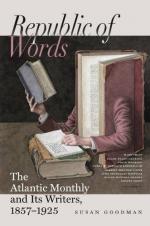Yet, despite its dead horses and vehicular entanglements, its vile concert saloons, the alternate meanness and magnificence of its architecture, the fragile character of its theatrical structures, and their limited and hazardous means of exit,—despite falling walls and the necessity of police guardianship at the crossings, the reckless driving of butcher-boys and the dexterity of pickpockets,—despite the slippery pavement, and the chronic cry for “relief,”—Broadway is a spectacle and an experience worth patient study, and wonderfully prolific of life-pictures. With a fountain at one end, like a French town, and a chime of bells at the other, like a German city, the intermediate space is as representative a rendezvous as can be found in the world.
The first thing that strikes an experienced eye in New York’s great thoroughfare is the paucity of loiterers: he sees, at a glance, that the flaneur is an exotic here. There is that in the gait and look of every one that shows a settled and an eager purpose,—a goal sought under pressure. A counting-room, office, court, mart, or mansion is to be reached punctually, and therefore the eye and step are straightforward, intent, preoccupied. But this peculiarity is chiefly obvious early and late in the day, when business and professional men are on their way to and from the place of their daily vocations. Later, and especially about two hours after noon, it is the dress and number of the other sex that win attention; and to one fresh from London, the street attire of ladies—or those who aspire, with more or less justice, to that title—is a startling incongruity; for the showy colors and fine textures reserved across the sea for the opera, the salon, and the fashionable drive, are here displayed on shopping expeditions, for which an English lady dresses in neutral tints and substantial fabrics,—avoiding rather than courting observation. The vulgar impression derived in Broadway from an opposite habit is vastly increased by modern fashions; for the apology for a bonnet that leaves brow, cheek, and head fully exposed,—the rustle and dimensions of crinoline,—the heavy masses of unctuous false hair attached to the back of the head, deforming its shape and often giving a coarse monstrosity to its naturally graceful poise and proportions,—the inappropriate display of jewelry and the long silk trains of the expensive robes trailing on the dirty walk, and continually caught beneath the feet of careless pedestrians,—all unite to render the exhibition repulsive to taste, good sense, and that chivalric sympathy inspired by the sight of female beauty and grace, so often co-existent with these anomalies. Broadway has often been compared to a kaleidoscope,—an appellation suggested by the variety of shifting tints, from those of female dress to those of innumerable commodities, from dazzling effects of sunshine to the radiance of equipage, vivid paint, gilded signs, and dazzling




